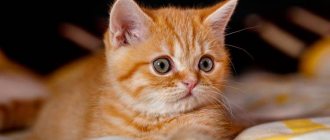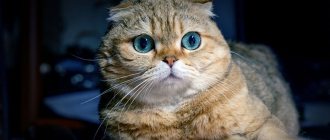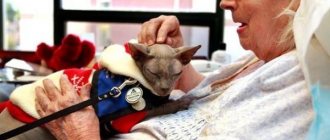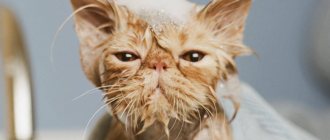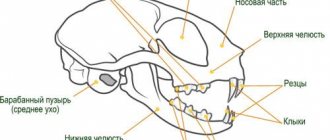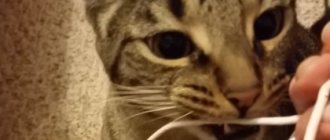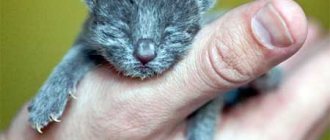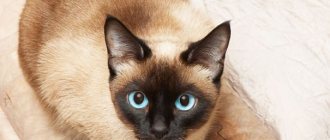Origin of black British cats
Breeders are convinced that monochromatic representatives of the breed appeared on our planet several thousand years ago. And if at first they could only be found in Rome, then later the animals began to be found in England, where they were brought by accident. Despite the fact that smoky and blue shades of fur predominated, black and white cats could also be found.
At the beginning of the 19th century, it was decided to assign certain colors to the breed. Then in 1898, Harrison Wyer, a famous breeder of that time, developed charcoal, chocolate and red.
Scottish straight colors
Depending on the color, the following types of Scottish Straights are distinguished: red; chocolate; black; blue; purple (rarely found and costs much more); marble or “whiskas”; white; beige or cream; tortoiseshell or tricolor.
Scottish straight cat photo
Lilac is a very rare color
Such animals are usually expensive.
Black or brown
They look incredibly impressive
Blue
Blue is the most popular color among Scottish Straights.
Marble
Otherwise it is called “Whiskas”. As you might guess, this color got its name thanks to a famous cat food advertisement.
White
White color is the most demanding. This “skin” will require special care.
Black British breed standard
A real black British cat can easily be confused with another breed. To prevent this from happening, you should know about all the features and nuances that will help you not to be deceived.
The head is a distinctive feature of all British people. She is large, round, with wide cheekbones and pronounced cheeks. The nose is always straight and short, and the forehead is flat and close to oval in shape. If you look at the chin, you can see that it seems to complement the whole picture with its massiveness and directness.
Important! If the animal's jaw is slightly narrowed, then it is not a British black cat, but a crossbreed or a representative of another breed.
Particular attention should be paid to the ears. They are small in size and slightly rounded at the tips. The ears are positioned in relation to each other at a ninety-degree angle. Particularly distinguished are the eyes of a cat - wide, large and open. The iris of the eye can change its shade in the first year and is established when the animal matures.
Many people define British people by their short and low body. Regardless of the gender of the animal, they are all massive and powerful. The same applies to strong and thick paws, as well as a dense, medium-length tail. The fur of felines is shiny and iridescent, with a thick undercoat. True Britons are so plush that sometimes it is impossible to reach their skin.
Features of wool
Black British cats become this way due to the amount of melanin in the hairs of the coat. The substance presented can be of two types, based on the gene - gene A is responsible for pheomelanin, and gene B is responsible for eumelanin. To achieve charcoal, you need to work on eumelanin. In addition, the intensity of the color is also important, and the D and C genes are responsible for it. In order to get a truly black Briton, the B and D genes must be in dominant quantities in the body.
At the same time, they also pay attention to the amount of pigment, which directly affects the hardness. Black representatives have more of it, so the fur coat is dense, and the pile cannot be called plush.
Black British kittens are a real rarity. The reason is that up to six months, and sometimes more, the coat color is brown or brown. And only after this the fur coat begins to change its shade. A true British black cat should be dark as night. The same applies to the nose mirror, as well as the paw pads. Any inclusions indicate a crossbreed and do not meet the breed standard.
Birth of black kittens
To get “coal” kittens, breeders need to try hard. It is worth choosing such parents, in whose pedigree there were as few four-legged crosses as possible, interspersed with a red tint or brown. It is best if the cat and cat have a solid color. And their parents are of the same tone. The ideal option is purebred black cats. However, even in this case, there is a possibility that the kittens will have some tint or remain brown. This happens all the time, so “coal” representatives are a rarity and a great success.
Color classification
A classification has been developed that divides the colors of animals of this breed into the following groups:
- solid;
- bicolor;
- tortoiseshells;
- tabby;
- tipped;
- color point, etc.
Solid colors
This group includes cases when the animal’s fur is uniformly colored with one rich color.
The main solid colors are:
White wool indicates the absence of the gene responsible for color. Pure white cats, as well as albinos, are extremely rare. At birth, they may have blue or black spots for a short period, which later disappear.
The eyes of Scottish cats with white fur may have a gray or amber tint. There are individuals with irises of different colors.
The Scottish Fold Lilac was recently developed and is considered rare. This group includes animals with light fur with a pinkish, deer, or lilac tint. Changes in color intensity are undesirable.
Scottish Fold solid color.
Solid black cats are rare. The presence of brown and red spots, as well as a grayish tint, is not allowed. Fold-eared and straight-eared cats often have a blue coat color. This category includes animals whose fur has a light gray tint. Some kittens have a pattern, but it disappears when they shed.
Scottish red cats are extremely rare. Such animals are distinguished by solid fiery red fur. The earlobe and pads are red. A faded pattern is allowed on the paws, forehead and tail.
Cream coloring is common among Scots. The animals have a reddish coat and a peach-colored undercoat. A vague pattern on the head in the forehead area is allowed, but the presence of leopard markings is unacceptable.
Eye color in black Britons
All Britons have blue eyes, but only up to four months. After this, the shade changes to gold. Some kittens may have green eyes, but breeders note that in this case the likelihood that the baby will turn black at the age of 6-7 months is zero. Just as there is no combination of blue eyes and a “charcoal” fur coat, there is no such combination, but with green eyes. According to the breed standard, the iris can be of all shades of gold, ranging from bright yellow to reddish. Nothing else is allowed.
Description of color
The uniqueness of the color is explained by the work of an inhibitor gene that blocks the manifestation of the coloring pigment. The undercoat and bases of the hairs are devoid of it and are therefore white or lightly colored. The upper part of the guard hair is intensely colored black or charcoal. This type of coloring is commonly called tipping. The degree of concentrated blackening reaches 2/3 or 4/5 of the length of the hair, but not less than 50%. Some breeds are characterized by the presence of a light “collar” around the neck. The complex color looks like a solid, monochromatic one, but when the animal moves, the villi diverge, exposing the light down, and the impression of living, iridescent fur is created. Owners of cats with such wealth note that periods of pronounced pubescence of the pet provide the most mesmerizing spectacle. Kittens may have uneven coat color, which evens out as they grow older.
Character of cats
Breeders note that the color of the coat does not affect the character of the pet in any way. At the same time, the owners fundamentally disagree with this. They are convinced that black cats are mysterious and unusual. In addition, four-legged animals are proud, self-sufficient and independent, although sometimes they need the company of people.
Animals don't like being forced to do anything. Therefore, if a “furry friend” does not want to be held or does not want to be in a room where there are people, then there is no need to force him to do so.
Representatives of the breed with black wool are energetically strong. Sometimes they sleep in one place for months, and then suddenly move to another. Many cats, when a person is sick, sleep with him or cuddle with him, helping to cope with the illness.
Contents of a Black Briton
Contrary to popular belief that the British are difficult to look after, the reality is completely different. If you follow simple rules of care, a four-legged animal can easily live up to 18, and sometimes 20 years.
General Content Rules
There are just a few nuances that you should pay attention to.
Namely:
- Avoid hypothermia of animals and do not place their houses in drafts. Representatives of these breeds have weak eyes. Therefore, at the slightest breath of wind, their eyes begin to water and sour.
- Visit a veterinarian regularly, especially for owners of animals over 10 years old, and get vaccinated.
- Feed your cats correctly.
- Do not allow frequent matings (for cats), this weakens the immunity of fluffies, they begin to get sick often.
Feeding a British cat
Caring for cats involves proper feeding. This can be high-quality dry food or canned food, as well as natural food.
Important! It is strictly forbidden to combine drying with food from the table, because this will lead to serious problems with the gastrointestinal tract.
First you need to decide, and then carefully select your diet. If preference is given to dry food, then it is better to choose the holistic or super-premium lines. Many brands offer food specifically for the British, taking into account their age.
At the same time, veterinarians advise choosing food based on the four-legged lifestyle. If the animal is overweight, then it is worth purchasing appropriate food. If the cat does not leave the house, therefore, it is necessary to purchase appropriate food. It's all written on the packs. In addition, veterinarians working in specialized pet stores will always give advice and help, so this will not be a problem.
Some owners worry that their British black kitten will go hungry while they are at work. Therefore, they leave the drying directly in the bowl, pouring it with a mountain. This cannot be done because, firstly, the feline’s stomach will quickly stretch out, and secondly, they will get used to the fact that they can eat as much as they want, and then they will not leave their feeder. Considering that the British are prone to obesity, doing this is strictly prohibited.
As for natural nutrition, in this case it is better to give preference to fresh meat. It could be rabbit, veal or turkey. It is advisable to avoid pork as it is too fatty. Before serving, the treat can be doused with boiling water and given to the animal immediately. To make food more nutritious, it is recommended to use vegetables. It could be pumpkin, zucchini or carrots. Some people grind the meat in a meat grinder, then grind the vegetables and make vegetable-meat balls, which the four-legged animals eat with pleasure.
Animals must be given eggs at least a couple of times a week. The same applies to dairy products. True, there should not be an excess of them. To maintain the charcoal shade of the coat, you can add kelp to your food from time to time. If the cat is repelled by the smell, then it is worth buying vitamin complexes that contain these algae and giving them.
You should forget about food from the table. British black cats, like representatives of other colors, begin to get sick if they consume fat, salt and spices in excess. All this is present in the food that a person eats. All this is prohibited for animals.
Grooming
Many people believe that the British Shorthair black cat's coat does not need to be looked after. However, it is not. If the animal is not combed at least once a week, the hairs will begin to tangle and cough. Therefore, this procedure cannot be avoided. To do this, it is better to buy a soft brush that will not injure the skin. During the molting period, procedures become more frequent, but they depend on the amount of undercoat being combed out. In order for an animal not to be afraid, it must be taught from childhood. Although, if you choose the right comb, there should be no problems with scratching.
Cats should not be bathed frequently. If the animal walks along the street, then “bath days” must be organized 2 times a year. For bathing, you should take shampoos designed specifically for black Britons. These cosmetics are sold in pet stores.
Feeding
British cats are not picky when it comes to nutrition and will eat almost anything that is offered to them. Therefore, it is necessary to create the right diet and feed your pet natural and high-quality food in order for him to be healthy, beautiful and active. Many people mistakenly believe that there is nothing better for cats than fish. Such a diet will not bring the necessary nutrients and vitamins to the animal’s body.
Pet stores offer a large number of types of food, both dry and wet. Some companies develop a special balanced diet intended only for this breed. Preference should be given to more expensive products; they contain more natural meat, fresh vegetables and nutrients.
If you are a supporter of natural products, you need to prepare daily portions yourself. Your cat should receive the necessary proteins from meat, natural fiber from vegetables and herbs, and you can sometimes add eggs and dairy products. From time to time, your pet needs to buy vitamins, which a veterinarian can recommend after an examination. Also, fresh water should always be freely available in the house.
How to choose a Black British kitten
To choose a black kitten, it is best to seek help from experienced breeders or those who already have similar animals. Otherwise, you need to rely only on your knowledge. First of all, you need to understand that the final color of British cats is formed with age. In childhood, babies are all dark, they have small ears and wide open eyes. If the “children” have purebred and “coal” parents, then you can try your luck and buy a “child”, in the hope that the shade of the fur coat will not change with age.
Don't go for cheap
Many people, wanting to buy a black cat, start saving. This circumstance plays into the hands of dishonest sellers who, under the pretext of a discount, sell animals a little cheaper, but at the same time, making a good profit for them. As a result, it turns out that the “coal” kittens lost their shade by six months, and only the name remained from the British. You should buy purebred fluffies exclusively from trusted people, whose names are well-known to many. In this case, sellers must show all documents for the parents.
Important! Black British cats are expensive. This is due to the complexity of breeding the breed, so there can be no talk of any price reduction in this case.
Read the breed standard
To avoid mistakes, you need to know the breed standard. The British have many distinctive features that you need to know. The main ones are that the eye color changes only by three to four months, and the shade of the coat, which will remain forever, can be observed only by six months. Therefore, it is worth buying an animal either at this age or earlier, hoping for a miracle.
